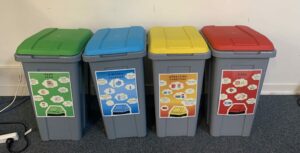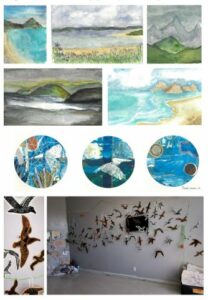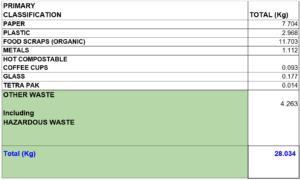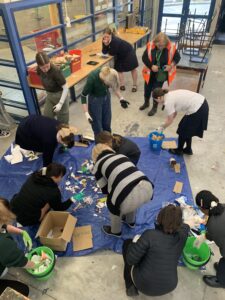Wins with waste

The new bin system is clearly labelled to help sorting.
The issue of waste can be good action-launching theme for many Enviroschools as there are often easy wins with waste reduction. Periodically this needs to be revisited to ensure everyone understands the concepts and decisions behind the current practices, and check that there is still progress and that the school and community is collectively moving towards the vision of Zero Waste. Whanganui Girls’ College (WGC) joined Paper 4 Trees in 2007, collecting paper to be recycled in exchange for native trees. Over time the designated bins vanished from classrooms. Recently students questioned this after being inspired by the “three bin recycling system” that they saw when visiting Palmerston North Girls’ High School for a Holistic Reflection.
Current students had also been looking at how “waste” materials could be incorporated in learning activities. This led to Year 10 technology students using only second-hand materials (such as old wire, paper, timber scraps, old curtain material) to create props for their Year 9 Matariki dance showcase. The Food room has installed a recycling system, and the Art department used recycled material for their Mana Moana installation.

Creativity reusing waste materials.

Sorting waste for the audit gives insights into food choices.
Year 10 students studied the albatross and what human-induced things can easily affect its lifespan (such as rubbish and ghost nets). They created prints and quotes with materials such as packaging that would normally be put in the bin, and then turned it all into an installation for the community to view. By incorporating quotes about albatrosses and their struggles with pollutants, students not only learn about the species but also about the environmental challenges they face. A quote from student J Hurley says ‘Sea surface temperature changes caused by global warming. This has caused Antipodean wandering albatross to forage further north where they encounter dangerous fishing fleets in the high seas and get killed’. The installation of the woodcut albatrosses caught in an old fishing net serves as a powerful visual representation of how rubbish in the ocean impacts the environment. Students can observe the connection between their artwork and real-world issues, fostering empathy and awareness of environmental issues.
Measuring change
 A whole school rubbish audit (all waste for one day) was undertaken in July 2023. This gave the College good evidence of the types of waste produced. This audit provided amazing visuals of what was ending up in the waste stream. Some of the waste content surprised students but also triggered conversations around students’ concerns about the lunch menu for that day. A waste audit showed that they produced 28kg of waste in a single day with food scraps the highest contributor at 11.7kg (42%), followed by paper (7.7kg – 27%).
A whole school rubbish audit (all waste for one day) was undertaken in July 2023. This gave the College good evidence of the types of waste produced. This audit provided amazing visuals of what was ending up in the waste stream. Some of the waste content surprised students but also triggered conversations around students’ concerns about the lunch menu for that day. A waste audit showed that they produced 28kg of waste in a single day with food scraps the highest contributor at 11.7kg (42%), followed by paper (7.7kg – 27%).
The audit allowed for lots of discussion, laughter, and led them to think about what could be recycled or repurposed. Immediate actions the students undertook were to divert the food waste to a teacher’s livestock, and other materials were sent to an Op shop.
Next steps
Other next steps have been to reinstate the paper bins and they have now introduced a fortnightly roster for the enviro girls to empty them. The caretakers have also come on board and are actively collecting the recyclable items from the food technology room and staff room.
The 2024 Head of Enviro, Maia Ballard has been working with her team to create posters for, and implement a council funded recycling system in all major traffic locations within the school. They have created some golden tickets as an incentive for students to begin using the bins correctly. The golden tickets allow students to be put into the draw to win prizes in assembly each week. The next waste audit on Friday the 1st of March will give an insight into how successful actions thus far have been and will also determine next steps.

Getting the audit completed – sorting into resource categories (banner image).